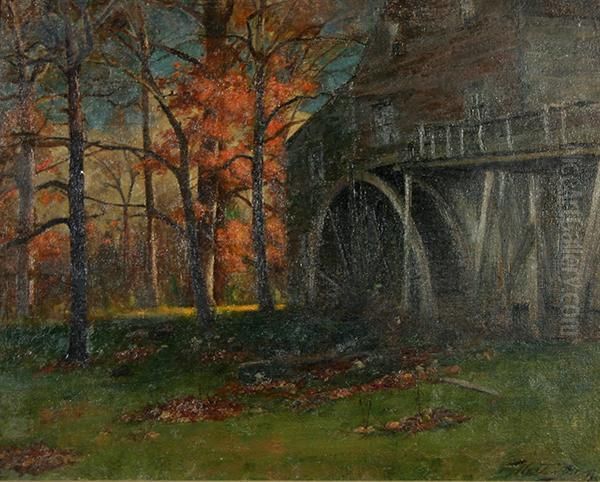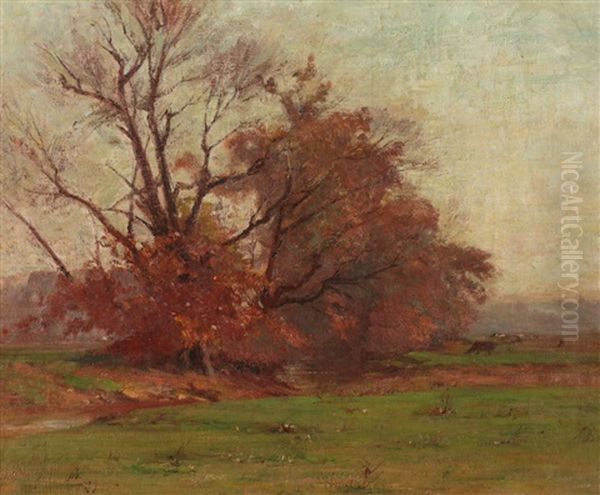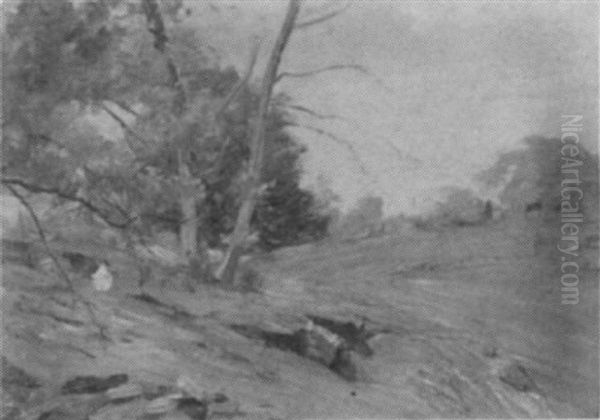Walter Leighton Clark (1859-1935) stands as a notable figure in the landscape of American art, particularly associated with the Impressionist movement that swept across the nation in the late 19th and early 20th centuries. His life and work offer a window into a period of significant artistic transformation, where American artists sought to forge a distinct national identity while engaging with the revolutionary ideas emanating from Europe, particularly France. Clark was not merely a painter but also an entrepreneur and a key figure in establishing institutions that supported American artists, leaving a multifaceted legacy.
To understand Walter Leighton Clark's contributions, it is essential to place him within the context of his time—an era marked by industrial growth, burgeoning cities, and an increasing American presence on the world stage. Artistically, this period saw a shift from the detailed realism of the Hudson River School and later luminists towards more subjective and expressive styles, with Impressionism playing a pivotal role.
Early Influences and Artistic Formation
Born in Philadelphia, Pennsylvania, Walter Leighton Clark's early artistic inclinations developed in an America that was increasingly looking towards Europe for cultural and artistic inspiration. While detailed specifics of his earliest training can be elusive, it was common for aspiring American artists of his generation to seek instruction either in established American art academies or, more prestigiously, to travel abroad, particularly to Paris, the undisputed art capital of the Western world.
The allure of Paris was immense. Academies like the Académie Julian and the École des Beaux-Arts attracted students from across the globe. Here, they would undergo rigorous training, often focusing on drawing from classical casts and live models. However, beyond the formal academies, Paris was a hotbed of avant-garde movements. The Impressionist exhibitions, though initially met with scorn by the conservative Salon, had, by Clark's formative years, begun to gain wider acceptance and exert a powerful influence. Artists like Claude Monet, Camille Pissarro, Edgar Degas, and Pierre-Auguste Renoir were revolutionizing the way light, color, and contemporary life were depicted.

It was within this dynamic environment that many American artists, including Clark, absorbed the tenets of Impressionism. They were drawn to its emphasis on capturing fleeting moments, the optical effects of light and color, and the practice of painting en plein air (outdoors). This approach stood in stark contrast to the meticulously finished, studio-bound works favored by the academic tradition.
Embracing Impressionism: An American Perspective
Walter Leighton Clark became a proponent of American Impressionism, a movement that adapted French Impressionist principles to American subjects and sensibilities. While French Impressionism often focused on Parisian city life, leisure activities, and the French countryside, American Impressionists like Clark turned their attention to the diverse landscapes of the United States, from the New England countryside to burgeoning urban scenes and tranquil coastal areas.
Clark's style often reflected the core characteristics of Impressionism: broken brushwork, a vibrant palette, and a keen interest in the atmospheric effects of light and weather. His landscapes, a significant part of his oeuvre, aimed to convey not just the topographical features of a scene but also the sensory experience of being present within it. He, like his contemporaries, sought to capture the ephemeral quality of light as it played across surfaces, changing with the time of day and the seasons.
He was part of a generation of American artists who formed a distinct school of Impressionism. Figures such as Childe Hassam, known for his flag paintings and depictions of New York City and New England; John Henry Twachtman, celebrated for his ethereal, Tonalist-inflected winter landscapes; Julian Alden Weir, whose work often featured Connecticut farm scenes; and Theodore Robinson, who had direct contact with Monet in Giverny, were all instrumental in popularizing Impressionism in America. Mary Cassatt, an American expatriate, was a core member of the French Impressionist group and played a crucial role in introducing Impressionism to American collectors.
Themes and Subjects in Clark's Art
Walter Leighton Clark's subject matter was varied, though he is perhaps best known for his landscapes and portraits. His landscapes often depicted serene, sun-dappled scenes, reflecting an appreciation for the natural beauty of the American environment. These works would have resonated with a public that was increasingly valuing nature as a respite from rapid industrialization and urbanization. His approach to portraiture, while perhaps more conventional in its aims, also benefited from the Impressionist emphasis on capturing the personality and momentary expression of the sitter through lively brushwork and attention to light.

While specific, universally recognized "masterpieces" by Walter Leighton Clark might not be as widely known as those by some of his more famous contemporaries, his body of work consistently demonstrated a skilled application of Impressionist techniques. He contributed to the overall richness and diversity of American art during this period. His paintings would have been exhibited in various venues, contributing to the growing appreciation for Impressionism among American audiences.
It is important to distinguish Walter Leighton Clark, the American Impressionist painter, from other notable figures with similar names, particularly the British artist and illustrator Walter Crane. While the prompt mentions a list of works including "The Princess Belle-Etoile" (1834 – a date preceding both artists' mature careers, likely a typo or misattribution in the source), "The Frog Prince," and "Beauty and the Beast," these titles are iconic examples of children's book illustrations and are definitively associated with Walter Crane (1845-1915), not Walter Leighton Clark. Crane was a central figure in the Arts and Crafts movement and a prolific illustrator whose style was quite different from American Impressionism.
Walter Leighton Clark's own artistic output focused on easel painting, primarily in oils, and his contribution lies within the realm of American Impressionist landscape and portraiture, characterized by a lighter palette and a focus on capturing the effects of natural light.
A Patron and Organizer: The Grand Central Art Galleries
Beyond his personal artistic practice, Walter Leighton Clark made a significant and lasting contribution to the American art world as an organizer and promoter of art. He was a key founder of the Grand Central Art Galleries in New York City, established in 1922. This was a pioneering initiative, conceived as a cooperative run by artists for artists, aiming to provide a stable and supportive venue for them to exhibit and sell their work.
The Galleries were located in Grand Central Terminal, a bustling hub of activity, ensuring high visibility for the art displayed. Clark, along with other prominent figures like John Singer Sargent (who, though an expatriate, maintained strong ties to the American art scene and whose bravura brushwork had Impressionistic qualities), Edmund Greacen (another American Impressionist), and the sculptor Daniel Chester French, envisioned a system where artists could bypass the traditional dealer system, which often took substantial commissions.

The Grand Central Art Galleries operated on a unique model. Lay members paid annual dues, and in return, they received a work of art by one of the member artists. This system provided artists with a regular income and a dedicated audience, while also fostering art appreciation and collecting among a broader public. Clark served as the president of the Galleries for many years, and his entrepreneurial spirit and dedication were crucial to its success. This initiative helped to democratize art access and support numerous American artists during a critical period.
The Wider Artistic Context: Contemporaries and Movements
Walter Leighton Clark's career unfolded during a vibrant and complex period in art history. While Impressionism was a dominant force, other artistic currents were also shaping the cultural landscape. In Europe, Post-Impressionism had already emerged, with artists like Paul Cézanne, Vincent van Gogh, Paul Gauguin, and Georges Seurat pushing the boundaries of art in new directions, emphasizing structure, emotion, symbolism, and scientific color theory, respectively. Cézanne's methodical deconstruction of form and his emphasis on the underlying geometry of nature would prove particularly influential for future generations.
In Britain, the aforementioned Walter Crane was a leading light of the Arts and Crafts Movement, alongside figures like William Morris. This movement, reacting against industrial mass production, championed craftsmanship, decorative design, and the integration of art into everyday life. Crane's illustrations, wallpapers, and textiles embodied these ideals, often drawing inspiration from medieval art, Japanese prints, and Renaissance aesthetics. His work, with its strong outlines and flat areas of color, was distinct from the optical concerns of Impressionism but shared a desire to break from academic conventions.
The Pre-Raphaelite Brotherhood, though an earlier 19th-century British movement, continued to cast a long shadow. Artists like Dante Gabriel Rossetti, John Everett Millais, and William Holman Hunt had sought a return to the sincerity and detailed realism of art before Raphael, often focusing on literary, historical, and religious themes with a strong symbolic content. Their influence could be seen in later Symbolist art and in the decorative tendencies of the Arts and Crafts movement.
In America, alongside Impressionism, Tonalism gained popularity. Tonalist painters, such as George Inness (in his later phase), Dwight Tryon, and James McNeill Whistler (whose work often bridged Tonalism and Aestheticism), favored muted palettes, soft atmospheric effects, and evocative, poetic moods over the bright colors and broken brushwork of Impressionism. Whistler, an American expatriate based in London and Paris, was a particularly influential figure, known for his "art for art's sake" philosophy and his sophisticated, harmonious compositions.
The Ashcan School, emerging in the early 20th century with artists like Robert Henri, John Sloan, and George Bellows, offered a grittier, more urban-focused realism, depicting everyday life in New York City's working-class neighborhoods. This stood in contrast to the often more genteel subjects of American Impressionism.
Walter Leighton Clark, therefore, operated within a rich tapestry of artistic styles and philosophies. His commitment to Impressionism placed him firmly within one of the major progressive movements of his time, yet he was undoubtedly aware of these other developments, which contributed to the dynamic artistic dialogue of the era.
The Legacy of Walter Leighton Clark
Walter Leighton Clark's legacy is twofold. As a painter, he contributed to the body of American Impressionist art, creating works that captured the beauty of the American scene through the lens of this influential style. His paintings reflect a dedication to the principles of light, color, and atmosphere that defined Impressionism, adapted to an American context. He was a skilled practitioner whose work found appreciation during his lifetime.
Perhaps more enduringly, his role as a founder and president of the Grand Central Art Galleries marks a significant contribution to the infrastructure of the American art world. This institution provided vital support for countless artists, fostering a community and a market for American art at a time when such support was crucial. His vision helped to create a model for artist-led initiatives and demonstrated a commitment to the well-being and promotion of his fellow artists.
His son, Eliot Clark (1883-1980), also became a respected painter, known for his landscapes and his writings on art, continuing the family's artistic lineage. Eliot's work often showed influences from Tonalism and later, a more abstract sensibility, reflecting the evolving artistic landscape of the 20th century.
In conclusion, Walter Leighton Clark (1859-1935) was an important figure in American art history. As an Impressionist painter, he embraced modern artistic ideas and applied them to American subjects. As an arts organizer, his work with the Grand Central Art Galleries had a lasting impact on the lives and careers of many American artists. His career exemplifies the dynamism of the American art scene at the turn of the 20th century, a period of growth, innovation, and the forging of a distinct American artistic identity in conversation with global movements. His contributions, both on canvas and in the broader art community, merit recognition and continued study.